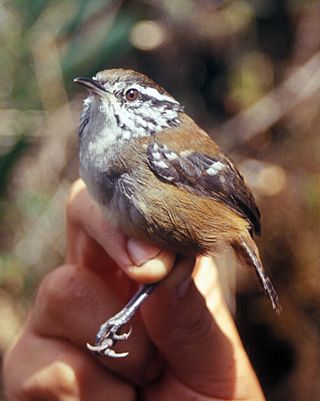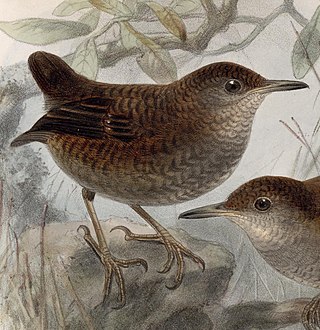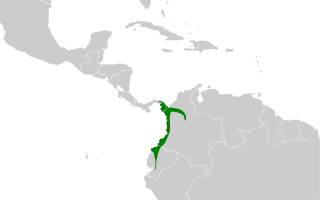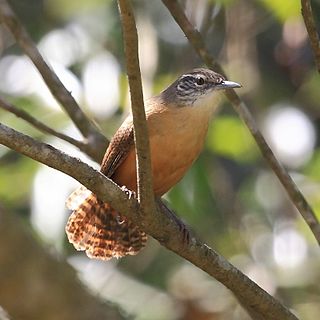
Wrens are a family, Troglodytidae, of small brown passerine birds. The family includes 96 species and is divided into 19 genera. All species are restricted to the New World except for the Eurasian wren that is widely distributed in the Old World. In Anglophone regions, the Eurasian wren is commonly known simply as the "wren", as it is the originator of the name. The name wren has been applied to other, unrelated birds, particularly the New Zealand wrens (Acanthisittidae) and the Australian wrens (Maluridae).

The rufous-breasted wren is a small songbird of the family Troglodytidae. It is found in Colombia, Costa Rica, Panama, Trinidad and Tobago, and Venezuela.

The Munchique wood wren is a member of the wren family (Troglodytidae) that was described as new to science in 2003. It is found in the Western Andes of Colombia.

The white-breasted wood wren is a small songbird of the wren family. It is a resident breeding species from central Mexico to northeastern Peru and Suriname.

The song wren is a species of bird in the family Troglodytidae. It is found in Colombia, Costa Rica, Ecuador, Honduras, Nicaragua, and Panama.

The southern chestnut-breasted wren is a species of passerine bird in the wren family Troglodytidae that is found in southern Peru and the extreme northwest of Bolivia. It was formerly considered to be conspecific with the northern chestnut-breasted wren with the English name "chestnut-breasted wren".

The grey-breasted wood wren is a species of bird in the family Troglodytidae. It is found from Mexico to Bolivia.

The bar-winged wood wren is a species of bird in the family Troglodytidae. It is found in southern Ecuador and northern Peru.

The southern nightingale-wren, also known as the scaly-breasted wren, is a species of bird in the family Troglodytidae. It is found in Bolivia, Brazil, Colombia, Costa Rica, Ecuador, Panama, Peru, and Venezuela.

The northern nightingale-wren, or nightingale wren, is a species of passerine bird in the family Troglodytidae. It is found in Belize, Costa Rica, Guatemala, Honduras, Mexico, and Nicaragua.

The stripe-throated wren is a species of bird in the family Troglodytidae. It is found in Colombia, Ecuador, and Panama.

The buff-breasted wren is a species of bird in the family Troglodytidae. It is found in the Amazon Basin of northern Brazil and Amazonian Colombia, Ecuador, Peru and northern-border Bolivia, and also the Guianan countries of Guyana, Suriname, and French Guiana. It occurs in non-Amazonian regions of Venezuela and Colombia and its range extends into eastern Panama.

The long-billed wren is a species of bird in the family Troglodytidae. It is endemic to Brazil.

The spot-breasted wren is a species of bird in the family Troglodytidae. It is found in Belize, Costa Rica, El Salvador, Guatemala, Honduras, Mexico, and Nicaragua.

The bay wren is a species of bird in the family Troglodytidae. It is native to southern Central America and northwestern South America.

The speckle-breasted wren is a species of bird in the family Troglodytidae. It is found in Colombia, Ecuador, and Peru.

The stripe-breasted wren is a species of bird in the family Troglodytidae. It is found in Honduras, Nicaragua, Costa Rica, and Panama.

Pheugopedius is a genus of wrens in the family Troglodytidae that are found in Central and South America.

The hermit wood wren or Santa Marta wood wren is a species of bird in the family Troglodytidae. It is endemic to the Sierra Nevada de Santa Marta of northern Colombia.



















